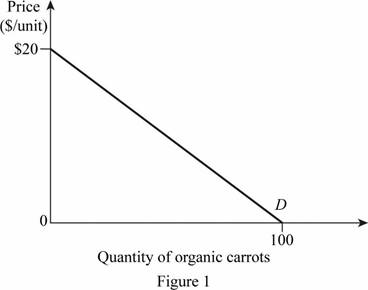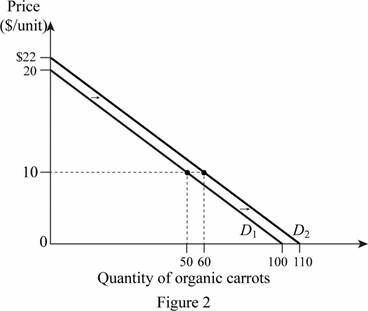
(a)
Graph the inverse
(a)
Explanation of Solution
Given information:
Demand function for organic carrots:
In Equation (1), “PO” is the
Price of conventional carrots (PC): 5
Average consumer income (I): 10
Calculation:
Demand equation can be simplified (with the price of the particular good alone) by substituting the respective values in Equation (1). This is done because when calculating the change in demand due to changes in the price of that good, all other factors are considered constant.
The demand equation when other things remain the same is
Rearrange Equation (2) in terms of price of the goods to derive the inverse demand equation.
Substitute quantity as zero in Equation (3) to calculate the price of organic carrots (maximum willing price).
Price of organic carrots is $20.
Substitute price as zero in Equation (3) to calculate the maximum quantity demanded.
Quantity of organic carrots is 100 units.
By using this information, the demand curve of organic carrots is illustrated below in Figure 1.

In Figure 1, the vertical axis measures the price of organic carrots and the horizontal axis measures the quantity of organic carrots. The downward sloping curve “D” is the demand curve of organic carrots.
Demand curve: A demand curve is a graph which shows the quantities of a commodity that the consumers will buy at different price levels.
(b)
The quantity demanded.
(b)
Explanation of Solution
At price $5, the quantity demanded for organic carrots
Quantity demanded for organic carrots at price $5 is 75.
At price $10, the quantity demanded for organic carrots
Quantity demanded for organic carrots at price $10 is 50.
(c)
Changes in demand for organic carrots.
(c)
Explanation of Solution
Given information:
Price of conventional carrots (PC): 15
Average consumer income (I): 10
Calculation:
Demand equation can be simplified (with the price of the particular good alone) by substituting the respective values in Equation (1). This is done because when calculating the change in demand due to changes in the price of the good, all other factors are considered constant.
The new demand equation when other things remain the same is
Rearrange Equation (4) in terms of price of the goods to derive the inverse demand equation.
Substitute quantity as zero in Equation (5) to calculate the price of organic carrots (maximum willing price).
Price of organic carrots is $22.
Substitute price as zero in Equation (5) to calculate the maximum quantity demanded.
Quantity of organic carrots is 110 units.
Substitute the value of price ($10) to calculate the quantity demanded of organic carrots at this particular price. This is done to know the change in quantity due to change in the price of PC.
Quantity demand of organic carrots at price $10 is 60. When the price of PC increases from $5 to $15, the quantity increases from $50 to $60.
By using this information, the change in demand curve of organic carrots is shown below in Figure 2.

In Figure 2, the vertical axis measures the price of organic carrots and the horizontal axis measures the quantity of organic carrots demanded. D1 is the initial demand curve of the organic carrots. The increase in the quantity demand for organic carrots shifts the demand curve from D1 to D2. It leads to increase the price from $20 to $22. At the initial demand curve, people demand 50 at the price $10; then it increases to 60 after the change in demand.
Demand curve: A demand curve is a graph which shows the quantities of a commodity that the consumers will buy at different price levels.
(d)
Demand for organic carrots.
(d)
Explanation of Solution
The demand for organic carrot increases. This increase in demand shifts the demand curve rightward. This rightward shift shows the two goods are substitute goods because increase in the price of conventional carrots increases the demand for organic carrots.
Substitute goods: Substitute goods are those goods that can be used for the same purpose.
(e)
Demand for organic carrots.
(e)
Explanation of Solution
The demand for organic carrot increases when the average income of consumer increases. Thus, it is clear that the organic carrots are normal goods.
Normal good: It is the good whose quantity demanded increases when the income of the consumer increases and vice versa.
Want to see more full solutions like this?
Chapter 2 Solutions
Microeconomics
- Section III: Empirical Findings: Descriptive Statistics and inferential statistics………………..40% Descriptive statistics provide details about the Y variable, based on the sample for the 10-year period. Here, you use Excell or manually compute Mean or the average income per capita. Interpret the meaning of average income per capita. Draw the line chart showing the educational performance over the time-period of your study. Label the Vertical axis as Y performance and X axis as the explanatory variable (X1) . Do the same thing between Y and X2 Empirical/ Inferential Statistics: Here, use the sample information to perform the following: Draw the Scatter plot and impose the trend line: showing the Y variable and explanatory variables ( X1). Draw the scatter plot and impose the tend line: Showing Y and X2. Does your evidence (data) support your theory? Refer to the trend line: Is the relationship positive or negative as expected? Create graphs based on table below; Years Y ( per…arrow_forwardPlease help me with this Accounting questionarrow_forwardTitle: Does the educational performance depend on its literacy rate and government spending over the last 10 years? In the introduction, there are four things to include:a) Clearly state your research topic follows by country’s background in terms of (population density; male/female ratio; and identify the problem leading up to the study of it, such as government spending and adult literacy rate. How does the US perform compared to other countries.b) State the research question that you wish to resolve: Does the US economic performance depend on its government spending on education and the literacy rate over the last 10 years. Define performance (Y) as the average income per capita, an indicator of the country’s economy growing over time. For example, an increase in government spending leads to higher literacy rates and subsequently higher productivity in the economy. Also, mention that you will use a sample size of 10 years of secondary data from the existing literature,…arrow_forward
- Title: Does the educational performance depend on its literacy rate and government spending over the last 10 years? In the introduction, there are four things to include:a) Clearly state your research topic follows by country’s background in terms of (population density; male/female ratio; and identify the problem leading up to the study of it, such as government spending and adult literacy rate. How does the US perform compared to other countries.b) State the research question that you wish to resolve: Does the US economic performance depend on its government spending on education and the literacy rate over the last 10 years. Define performance (Y) as the average income per capita, an indicator of the country’s economy growing over time. For example, an increase in government spending leads to higher literacy rates and subsequently higher productivity in the economy. Also, mention that you will use a sample size of 10 years of secondary data from the existing literature,…arrow_forwardExplain how the introduction of egg replacers and plant-based egg products will impact the bakery industry. Provide a graphical representation.arrow_forwardExplain Professor Frederick's "cognitive reflection" test.arrow_forward
- 11:44 Fri Apr 4 Would+You+Take+the+Bird+in+the+Hand Would You Take the Bird in the Hand, or a 75% Chance at the Two in the Bush? BY VIRGINIA POSTREL WOULD you rather have $1,000 for sure or a 90 percent chance of $5,000? A guaranteed $1,000 or a 75 percent chance of $4,000? In economic theory, questions like these have no right or wrong answers. Even if a gamble is mathematically more valuable a 75 percent chance of $4,000 has an expected value of $3,000, for instance someone may still prefer a sure thing. People have different tastes for risk, just as they have different tastes for ice cream or paint colors. The same is true for waiting: Would you rather have $400 now or $100 every year for 10 years? How about $3,400 this month or $3,800 next month? Different people will answer differently. Economists generally accept those differences without further explanation, while decision researchers tend to focus on average behavior. In decision research, individual differences "are regarded…arrow_forwardDescribe the various measures used to assess poverty and economic inequality. Analyze the causes and consequences of poverty and inequality, and discuss potential policies and programs aimed at reducing them, assess the adequacy of current environmental regulations in addressing negative externalities. analyze the role of labor unions in labor markets. What is one benefit, and one challenge associated with labor unions.arrow_forwardEvaluate the effectiveness of supply and demand models in predicting labor market outcomes. Justify your assessment with specific examples from real-world labor markets.arrow_forward
- Explain the difference between Microeconomics and Macroeconomics? 2.) Explain what fiscal policy is and then explain what Monetary Policy is? 3.) Why is opportunity cost and give one example from your own of opportunity cost. 4.) What are models and what model did we already discuss in class? 5.) What is meant by scarcity of resources?arrow_forward2. What is the payoff from a long futures position where you are obligated to buy at the contract price? What is the payoff from a short futures position where you are obligated to sell at the contract price?? Draw the payoff diagram for each position. Payoff from Futures Contract F=$50.85 S1 Long $100 $95 $90 $85 $80 $75 $70 $65 $60 $55 $50.85 $50 $45 $40 $35 $30 $25 Shortarrow_forward3. Consider a call on the same underlier (Cisco). The strike is $50.85, which is the forward price. The owner of the call has the choice or option to buy at the strike. They get to see the market price S1 before they decide. We assume they are rational. What is the payoff from owning (also known as being long) the call? What is the payoff from selling (also known as being short) the call? Payoff from Call with Strike of k=$50.85 S1 Long $100 $95 $90 $85 $80 $75 $70 $65 $60 $55 $50.85 $50 $45 $40 $35 $30 $25 Shortarrow_forward

 Principles of Economics (12th Edition)EconomicsISBN:9780134078779Author:Karl E. Case, Ray C. Fair, Sharon E. OsterPublisher:PEARSON
Principles of Economics (12th Edition)EconomicsISBN:9780134078779Author:Karl E. Case, Ray C. Fair, Sharon E. OsterPublisher:PEARSON Engineering Economy (17th Edition)EconomicsISBN:9780134870069Author:William G. Sullivan, Elin M. Wicks, C. Patrick KoellingPublisher:PEARSON
Engineering Economy (17th Edition)EconomicsISBN:9780134870069Author:William G. Sullivan, Elin M. Wicks, C. Patrick KoellingPublisher:PEARSON Principles of Economics (MindTap Course List)EconomicsISBN:9781305585126Author:N. Gregory MankiwPublisher:Cengage Learning
Principles of Economics (MindTap Course List)EconomicsISBN:9781305585126Author:N. Gregory MankiwPublisher:Cengage Learning Managerial Economics: A Problem Solving ApproachEconomicsISBN:9781337106665Author:Luke M. Froeb, Brian T. McCann, Michael R. Ward, Mike ShorPublisher:Cengage Learning
Managerial Economics: A Problem Solving ApproachEconomicsISBN:9781337106665Author:Luke M. Froeb, Brian T. McCann, Michael R. Ward, Mike ShorPublisher:Cengage Learning Managerial Economics & Business Strategy (Mcgraw-...EconomicsISBN:9781259290619Author:Michael Baye, Jeff PrincePublisher:McGraw-Hill Education
Managerial Economics & Business Strategy (Mcgraw-...EconomicsISBN:9781259290619Author:Michael Baye, Jeff PrincePublisher:McGraw-Hill Education





